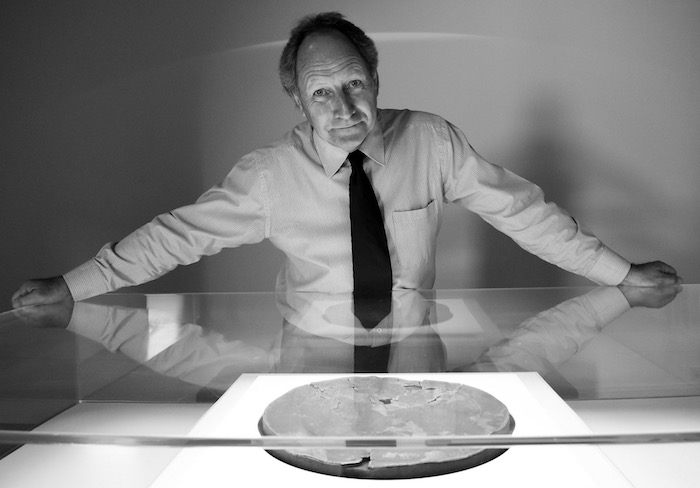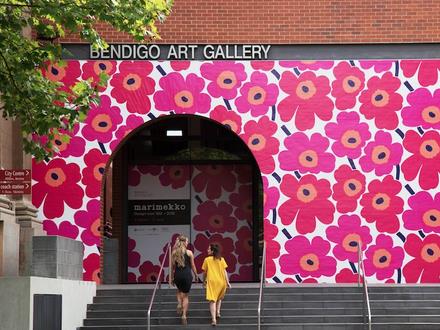Facade of the Bendigo Art Gallery.
Though Australia only has a handful of major state art galleries and contemporary art spaces, there are literally hundreds of art galleries across our metropolitan cities and regional areas that offer professional opportunities for aspiring gallery directors.
At the helm of these organisations are a corp of directors who are just as rigorously driven in delivering top drawer curatorial programming – erudite and engaging exhibitions that connect with audiences and offer a national dialogue. And, because these are typically smaller institutions, they are also more nimble to change, more hands on and, at times, more demanding on the individual.
ArtsHub spoke with three gallery directors in the attempt to unpack the skills needed, the passion required, and the diplomacy and lobbying it takes to deliver funding and juggle the many hats of a gallery director.
Located in regional Victoria, Director of the Bendigo Art Gallery, Karen Quinlan told ArtsHub that she wasn’t looking for the job when it landed on her lap.
‘To be honest, sometimes the best situations you find yourself in may not necessarily be engineered by you. As the Bendigo Art Gallery Curator I was completely immersed in the collection and the concept of being the boss wasn’t my aim. When the role was offered l was impressed and a new untapped professional side emerged,’ she said.
Michael Dagostino, is the Director of Campbelltown Arts Centre (CAC). He rigorously pushes a commissioning heavy program that is nationally and internationally recognised.
Dagostino said that as director of such a progressive art centre he is, ‘privileged to work directly with amazing curators and producers to curate an artistic program that challenges us all; and this excites me.’
He continued: ‘Being the director gives me the opportunity to connect directly with artists, the community and our audience.’
Both directors believe that the success of their galleries derives from the push to redefine what it means to be regional, or defined by location. And in producing the very best programs possible, that footing with larger institutions nationally can be guaranteed.

Karen Quinlan, Director Bendigo Art Gallery; Photo by Bill Conroy.
What does life look like as a gallery director?
As one escalates up the career path within the gallery sector, typically the ratio of time spent working on exhibitions and the time spent in meetings shifts.
Dagostino explained: ‘Some say all I do is go to a lot of lunches and coffee meetings but most of my day is sitting in front of the computer responding to emails, solving problems, building relationships and partnerships, identifying new funding opportunities and then I spend a bit of time talking about art, both creating and curating. That’s the best bit.’
Quinlan’s day sounded very similar: ‘Everything is discussed which is the advantage of a smaller team … Essentially, everyday is different, which is why l don¹t have time to be ill and l hardly ever take a day off.’
She continued: ‘Then there are evening functions and events from openings, talks or sponsor, philanthropic related activities. I also serve on some external boards and have been appointed to State Government advisory committees. Some of this involves travel to and from Melbourne.’
When ArtsHub spoke with Dagostino he was in Bendigo on gallery business, and Quinlan was also on the road. Travel is a key aspect of many of these non-city gallery directors to ensure that their organisations remain in the national presence and discussion.
‘It’s the ability to think strategically, and this macro thinking extends beyond the walls of the institution. The impact of cultural tourism and how the Bendigo Art Gallery brings social, cultural and economic benefits to the region and to the State are a fixation for me,’ said Quinlan.
Often this tier of galleries has a close relationship with government. Quinlan explained: ‘The Gallery is also a business unit within the City of Greater Bendigo, so various organisational meetings are scheduled which the gallery is part of. Likewise, the University has a meeting cycle and if it’s relevant to my role I will attend.’
In her position, Quinlan is not only responsible for the running of Bendigo Art Gallery but is also, Director of the La Trobe Art Institute (LAI), part of the University of La Trobe.
‘My days are spent juggling Gallery business with LAI business. Fortunately the two positions have tremendous synergies so the overlap and blending of the roles means that the impact for both organisations is greater,’ said Quinlan.
‘l like to think that l am still learning, still growing and refining the role,’ she concluded.

Michael Dagostino, Director Campbelltown Art Centre; photo Nikki To
The advantage over a state institution
Quinlan reminded that smaller institutions can move quickly. ‘As the Director of a small team you hear the alarm bells faster. A small team can be very proactive and decision making may be faster … l can also delve into the detail when l need to. I know everyone individually within my staff and that¹s a plus for any organisation.
‘The flipside is that budgets are tight, contingency plans are limited, so often we are working with tight and unrealistic budgets alongside the bold ambition,’ she said.
For Dagostino is was the personal contact that the job allowed, which was perhaps less siloed than a larger institution.
‘It’s the direct contact with artists, audiences and working with a small team. There’s always a wide range of tasks involved to produce an exhibition or performance. I take on a very hands-on approach to being a director, to be ready to get in there when necessary to ensure that our artistic program is a success,’ said Dagostino.
Quinlan added: ‘In a small institution your individual contribution will be noticed and acknowledged, however mistakes and misadventure will be exposed more readily.’
It was a point that Richard Mulvaney, Director and Manager of Exhibitions at The Queen Victoria Museum and Art Gallery (QVMAG) in Launceston (TAS) agreed upon.
‘I think it is the immediacy of what you do. Decisions you make one day are often put into effect the next. Regional museums/galleries do not have the resources of capital city counterparts yet in many cases it is the regional museums/galleries that hold the major proportion of our national collection. I suppose we “make do” with often very surprising results. The other is the connection you have with the community around you. There is a much greater sense of public ownership and access. You also get a lot of opinions,’ he said.

Richard Mulvaney with the Dirk Hartog plate that visited QVMAG in November 2017
What’s the best part of the job?
For Dagostino it was an easy answer. ‘I love walking through an exhibition and knowing some of the people who attend, saying hello and asking them what they think about the work. We have a real sense of community at Campbelltown Arts Centre and it’s that connection I truly enjoy.’
Quinlan says the best part of her job is ‘knowing that the Bendigo Art Gallery is strongly positioned within the sector and its reputation extends globally is enough to help me sleep at night!’
Mulvaney, who has worked in the museum/gallery sector all his working life, said for him it was the love of the collection. ‘What I love about them is the public accessibility that they give to our collections and research. While virtual is taking off in many forms, the public still like to connect with objects and the stories behind them. They form part of where we have come from in the broadest sense and help to chart where we are going. So seeing the public engaged in all that we do is my most rewarding times,’ he said.
How real are the challenges on a daily basis?
While it can sometime be confronting, Dagostino felt the personal contact in a small gallery is more of an advantage than a challenge. He explained: ‘If there is something about an exhibition, the audience are very likely to tell you their opinions to your face; either they thought it was the greatest thing they have ever seen or the worst. You don’t get this type of feedback from an online survey form. Also, as the Artistic Director of Campbelltown Arts Centre, it then comes back to the direct ability to work with artists on their projects.’
Quinlan told ArtsHub that ‘taking on the role of a regional gallery directorship is not for the faint hearted and can be challenging particularly if you move from a larger city. It can be isolating in the first instance.’
The challenges, however, are very layered. She said: ‘The greatest challenge exist within the institutional landscape in Australia. We have larger State funded institutions within the main cities, and then a significant gap in size and scale with our regional institutions. Naturally, fund raising is important for state and regional galleries, however a locally government funded institution will have limited capacity to achieve great heights if the rate base is small and if it is solely local government, which is the situation many regional galleries find themselves in.
‘Alongside this is a smaller pool of donors. Philanthropy is important for all cultural institutions, and for regional galleries existing in the most socio economically challenged parts of Australia the task can be significant if the ambition is great,’ said Quinlan.
She said that success for Bendigo Art Gallery has been getting that balance right, and attracting funding from outside the region that can help the gallery become a greater force within the sector.
From a regional perspective, Quinlan added that taking on the role of a regional gallery directorship ‘can be challenging particularly if you move from a larger city. It can isolating in the first instance.’
Advice to someone wanting a career as a gallery director
Dagostino’s key piece of advice was to get in the door and observe the job first. ‘Become a curator in the type of gallery you would like to become director in. It may not be the gallery that you end up being director for, but it will give you a sense of the issues and opportunities that the director faces whilst having the ability to connect with the local community,’ he told ArtsHub.
Located in regional Victoria, Quinlan advocated for those who are ambitious to cut their teeth outside the city, where you will get a broader gallery grounding. She told ArtsHub that she felt she was ‘living the dream’.
‘Time in the country is good for you. If makes you appreciate the positive side of smaller communities and you are undoubtedly closer to the natural environment. The lifestyle has many advantages. The collections are historically rich and eclectic and often surprising for visitors.’
Mulvaney’s advice was: ‘Don’t go into it for the money! Having said this there are so many other rewards. If you want a career in the sector certainly consider tertiary education as it provides the foundation for where you might want to go.
‘Once that becomes more clear, volunteer in a museum/gallery to really spend some time to find out if this is what you really want to do. Having the education and experience is a big asset when you go to your first interview. Above all be enthusiastic. You have always got to love what you are doing. And I have loved my job.’
Bendigo Art Gallery is currently showing the 2018 Paul Guest Art Prize (30 June – 9 September 2018). For more visit their website www.bendigoartgallery.com.au
Campbelltown Art Centre is showing Looking In: A Survey of David Hawkes from 1989 to Now until 29 July, and Australian Artist of the 80s until 14 October. For more visit their website c-a-c.com.au





